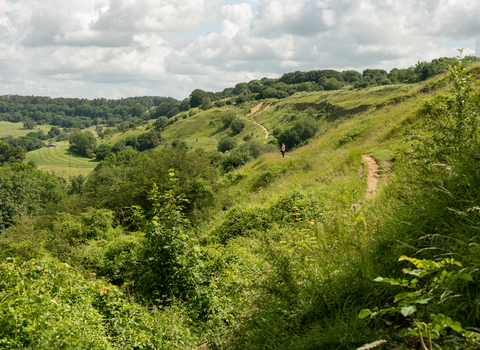Gloucestershire has some fantastic wild green spaces, brimming with wildlife and historical importance, these are great places to connect with nature.
Over the last 60 years, Gloucestershire Wildlife Trust has saved many special places, the wildlife they support and has even managed to bring some species back from the brink, like the once-extinct large blue butterfly, but despite our efforts, wildlife is still declining.
Nature reserves were the cornerstone of twentieth century conservation and integral to the establishment of the Wildlife Trusts, however most nature reserves are too small to ensure the long-term future of the species they were designated to protect. The 2010 landmark Lawton Report called for UK conservation focus on increasing the size of wildlife sites (bigger), improving the quality of the habitat they contain (better), creating new wildlife sites (more) and connecting them across landscapes (joined up).
This is where Nature Recovery Zones come in. It’s an approach that means working closely with our neighbouring landowners and farmers beyond the boundaries of nature reserves to create much larger wildlife-friendly areas that importantly connect with each other, effectively creating ‘super reserves’.
Discover more about Nature Recovery Zones and how they'll help us halt wildlife declines and put nature into recovery with Ellie Harrison, former GWT President, in the short film below.
The Cotswolds Escarpment
Peppered with quintessentially English villages of honey-coloured stone and rolling hills, the Cotswolds attracts visitors from the world over. Appropriately designated an Area of Outstanding Natural Beauty, it covers almost 800 square miles across parts of six counties and hosts some of the country's rarest habitats like species-rich grasslands and ancient woodlands.
An escarpment is formed by a tilted layer of hard rock breaking through the Earth's surface, and the Cotswold Escarpment is a steep ridge of limestone that was formed in the Jurassic period. With its highest point 700ft above sea level, it offers some fantastic views.

Coombe Hill (c) Nathan Millar
Severn Hams
An important triangle of the Severn Vale, this largely flat and open landscape is defined by the River Severn and its floodplains. Agriculture has featured prominently here, and the area is home to several nationally important wetlands.
The Severn Hams get their name from the Saxon word ‘ham’ or ‘hamm’, meaning water meadows or floodplains. Thousands of wetland and wading birds occupy these wide-open vistas - like the curlew, lapwing and avocet, especially in the winter months, alongside rare plants, eels and invertebrates that can be found here.
This Nature Recovery Zone could play an important role in managing water and storing carbon through wetland creation in the future, which is becoming ever more important in our changing climate.
Windrush Valley
Carved by the River Windrush, this valley meanders through some of the county’s most bucolic rural countryside and ancient woodlands before feeding into the River Thames.
While much of the land is arable and pasture farmland, along the slopes of the river valley and its tributaries lie some astonishing fragments of unimproved grasslands, floodplain meadows and marshland. Over the last 50-100 years, the landscape has been transformed as riverside pastures were intensified or became arable farmland. The rivers here are in a better condition than most in the county, partly thanks to the long-term work of GWT and its partners.
The mosaic of floodplain meadows, grasslands and other habitats mean many species are found here, including Cotswold pennycress in arable field margins and some very scarce beetles and insects including the ruby-tailed wasp, scare thorn case-bearer moth and dingy meadow pigmy moth.
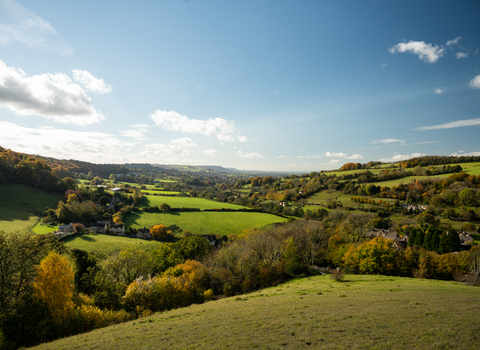
Swifts Hill (c) Nathan Millar
Slad Valley
This tranquil, hidden valley is teeming with wildlife and showcases some of the best limestone grassland that our county has to offer. Like many of the valleys and banks we care for, the steep slopes have escaped agricultural practices and development. For this reason, it is one of the best areas in the county to spot a huge variety of wildflowers, especially orchids - including fly and musk orchid.
The streams in the Slad Valley are home to the threatened white-clawed crayfish, and we are working with local organisations to protect these native crustaceans from diseases spread by their invasive cousins.
The rich habitat mosaics reflect the diversity of wildlife found in the valley, including the rare mountain Bulin snail and the now threatened juniper tree.
Stroud Commons
From rolling, Cotswold grasslands to hidden pockets of woodland, the nature reserves we care for in the Stroud area are treasured by the local community. An active volunteer group of local people works hard to care for Box Wood - a tranquil, leafy woodland tucked away in a valley filled with towering beech trees. The neighbouring wildflower meadows of Stuart Fawkes are grazed by cattle, similarly to the National Trust’s Minchinhampton and Rodborough Commons, with hopes that complementary management styles for Stroud’s limestone grasslands will enable numbers of threatened wildflowers to recover – including bird’s-nest orchid and meadow clary.
Species-rich grasslands have undergone drastic declines over the last 70 years. These are not only a hotspot for species biodiversity, but they also keep soil healthy, carbon-rich and protect it from erosion. The native broadleaved ancient woodlands are important strongholds for lesser horseshoe bats.
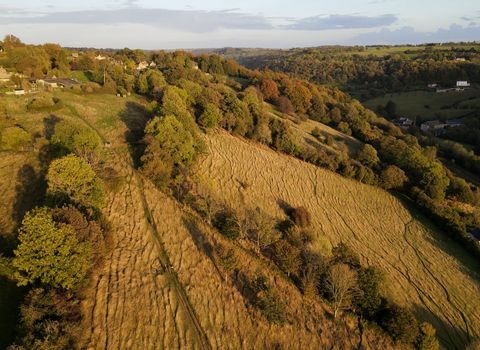
Blackness Banks (c) Billy Heaney
The Golden Valley
Stretching from Stroud to Sapperton, the Golden Valley is a wildlife-rich gem that has been shaped by the River Frome and is at the forefront of ground-breaking work to improve habitats for insects.
Steep slopes and limited accessibility largely protected it from agricultural practices and development, so it has retained areas of nationally important habitats - predominantly diverse grasslands interspersed with ancient woodlands. It’s also home to one of the world’s largest populations of the endangered large blue butterfly.
Many species rely on these habitats, like rugged oil beetles, dotted bee flies and marsh fritillary butterflies. Historic hazel coppicing makes it an ideal home for hazel dormice and pearl-bordered fritillary butterflies, while green-winged and greater butterfly orchids dot the landscape.
Daneway Banks Siccaridge Wood Sapperton Valley
Central Forest
This enchantingly diverse landscape stretches from Parkend and Nagshead, through to Cinderford and Mitcheldean, all the way to the Herefordshire border. It is a real mosaic of different habitats, encompassing shady forested areas filled with ferns, blankets of purple heather, lakes, marshes and the rolling landscape of surrounding pasture and ancient woodland.
This Nature Recovery Zone supports one of England’s most important pine marten populations, following a reintroduction programme that began in 2019.
Many of the wild places we care for here form a significant part of the Statutory Forest of Dean, so we work in close partnership with Forestry England.
This area is nationally important for woodland birds and invertebrates, whilst the Wye Valley and Forest of Dean Bat Special Area of Conservation is of international importance for its population of lesser and greater horseshoe bats.
Woorgreens Wigpool Stenders Quarry
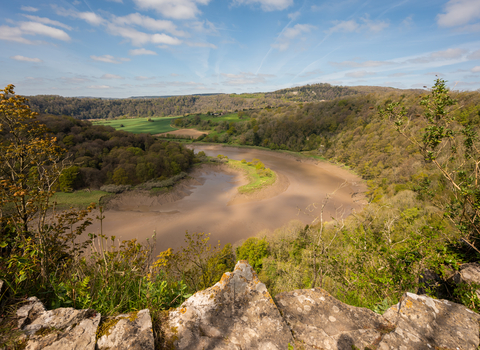
Lower Wye and Tidenham Chase
Nestled between the Severn Estuary and the River Wye, this area is characterized by steep ancient woodlands of beech, lime and yew. The Wye gorge supports a rich array of plants, fungi and insects, and there are several important lesser horseshoe and barbastelle bat sites found here.
As you move west the landscape transitions to a mosaic of pasture, arable and conifer plantations, interspersed with precious fragments of species-rich grasslands and heathlands, which are part of a broader network crossing into Wales.
Heathland is scarcer than rainforest on a worldwide scale, which is one of the reasons why Poor’s Allotment and The Park nature reserves are so important.
Heathland, scrub, meadows and ancient woodlands host plants like narrow-leaved helleborines and bog mosses, which bring in insects like long-horned bees and white admiral butterflies. A diverse array of birds can also be found here, from nightjars and cuckoos to lesser redpolls and firecrests, while peregrine falcons nest in the cliffs.
Ban-y-Gor Lancaut The Park and Poor's Allotment Ridley Bottom Simpson's Meadow
Leadon Valley
Despite their proximity, the landscape of the Leadon Valley contrasts with the Wye Valley, offering a different array of habitats. There are large areas of rolling arable farmland, dotted with small fragments of wildlife-rich habitat, such as ancient woodlands. The Valley is also home to the ‘golden triangle’, a stronghold of native, yet increasingly rare, wild daffodils that are present here in huge numbers.
The Leadon Valley could showcase how wildlife can also thrive alongside extensive food production. By shifting away from intensive practices, wildlife-rich headlands and hedges can make the landscape more suitable for a wide range of species. It is possible to produce food whilst capturing significant amounts of carbon and improving water management and water quality in the River Leadon catchment.
The variety of closed canopy and more open woodland habitats in the Leadon Valley are vital for the population of Bechstein's and Natterer's bats found here.
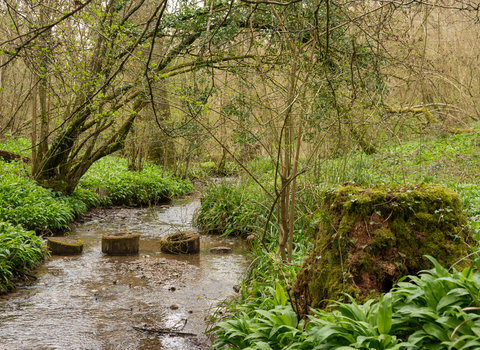
Midger Wood (c) Nathan Millar
Lower Woods to Westonbirt
Lying predominantly in the Vale of Berkeley between the steep Cotswold escarpment and the mighty River Severn, this area is dominated by ancient woodland – particularly that of Lower Woods, the largest nature reserve in our care at over 280 hectares.
Connectivity is key here, not only within the woodlands themselves, but to the wider landscape. Beneath the trees work is carried out to thin selected areas, keeping glades and rides open for a host of wildlife that thrives in the dappled sunlight, long grasses and woodland edges – including wildflowers, amphibians, bats and butterflies such as the white admiral.
As well as swathes of ancient and coppiced woodlands, this area also features species-rich meadows and rivers, which draw in birds like dippers and spotted flycatchers.

